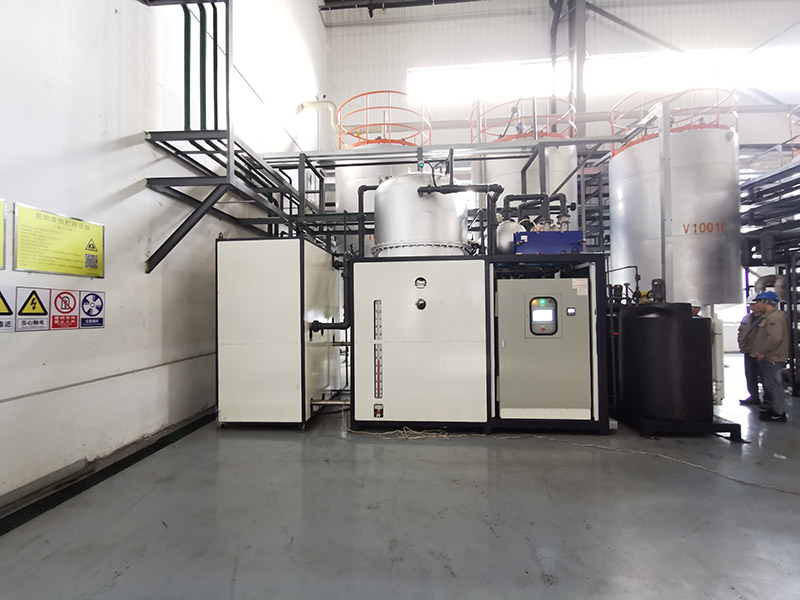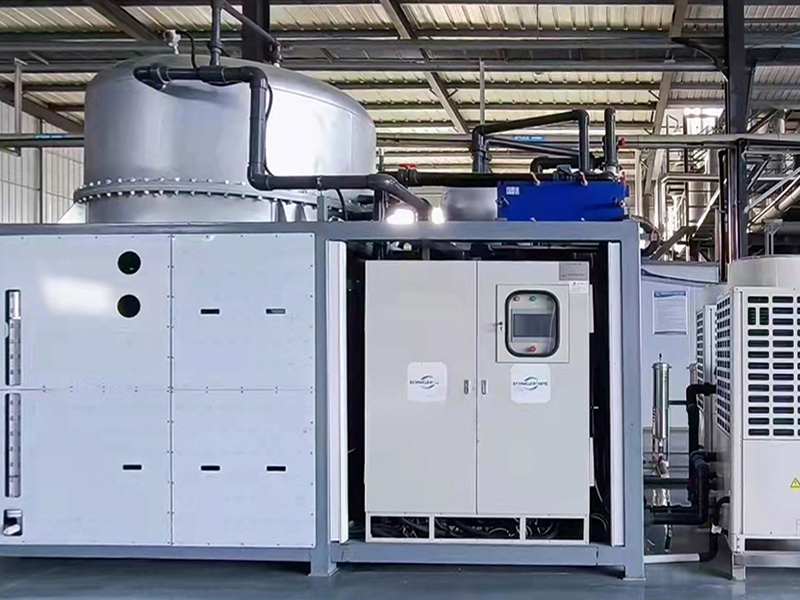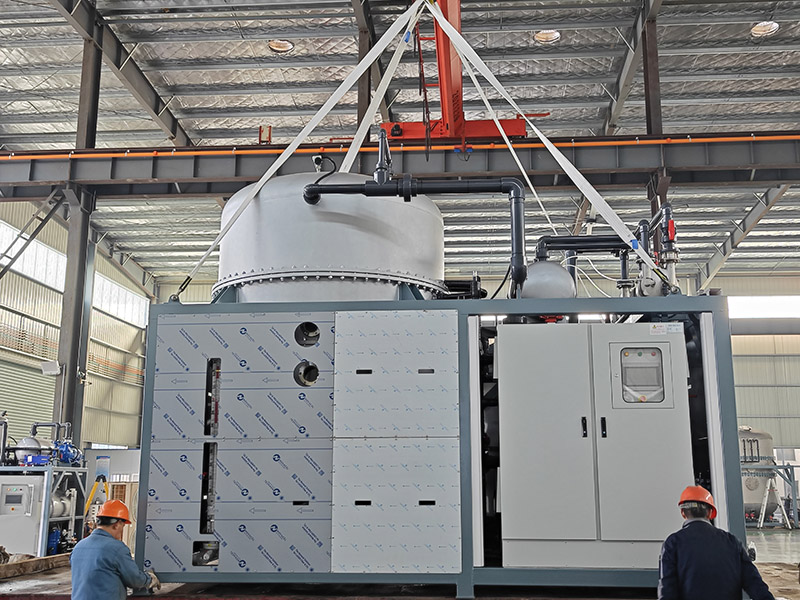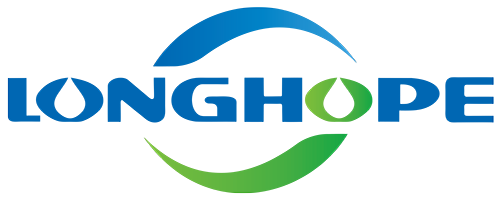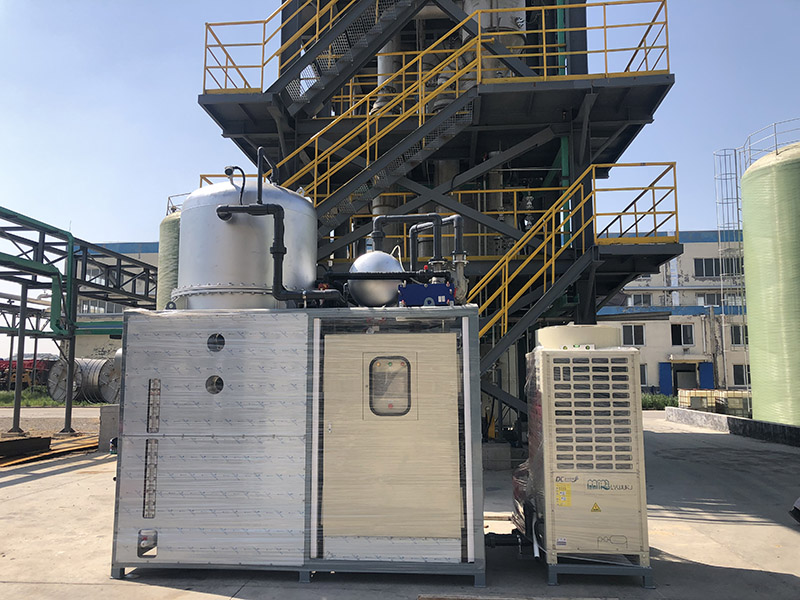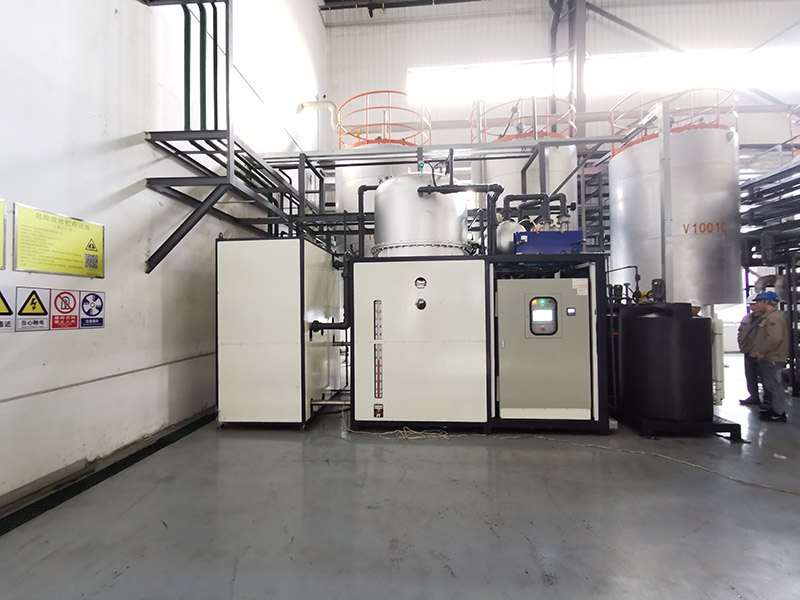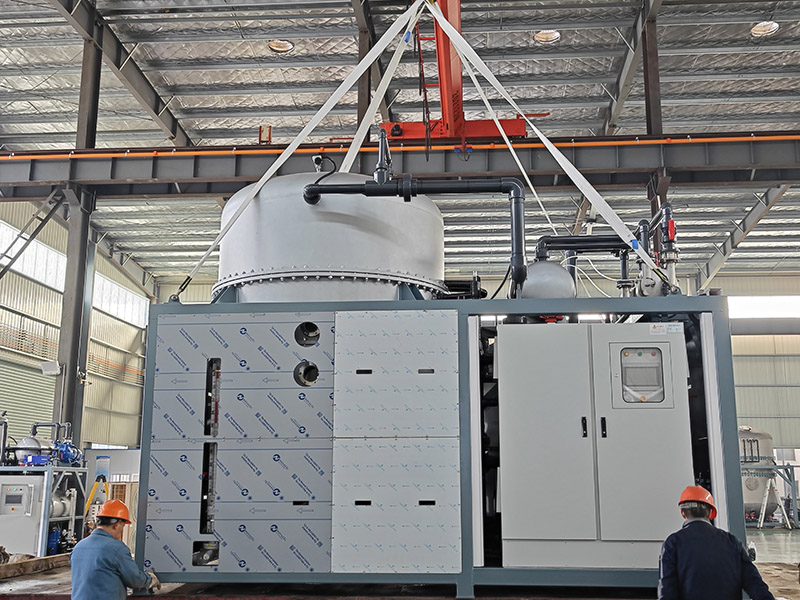Low Temperature Evaporationv-HP-SF-20000
At present, industrial waste liquid treatment is commonly used by physical and chemical methods, membrane treatment, high temperature distillation, biochemical treatment, low temperature evaporation method and other treatment methods. The advantages of low temperature evaporation system are low temperature evaporation, not easy to produce scale, the process chain is very short, the equipment is simple to operate, the degree of automation is high, the concentration efficiency is higher, the maintenance is more convenient, and the industrial waste liquid standard treatment, waste liquid concentration, waste liquid recycling, special waste liquid treatment and other aspects have been well applied.
Concentration of waste liquid
Concentration of landfill leachate
Landfill leachate is a kind of high concentration organic waste liquid, which has the characteristics of high COD concentration, high chroma, high odor and difficult treatment. At present, the reverse osmosis (RO) technology will still produce about 20% to 50% of the waste liquid treatment capacity of high salt, high chroma, high COD, difficult to biodegrade RO concentrated liquid. The concentrated liquid is generally treated by backburning and recharging, but the effect is not obvious and there are problems of high energy consumption.
Based on the shortcomings of the current membrane concentration process of landfill leachate concentrate, the concentrated leachate is further concentrated by vacuum low-temperature evaporation. Inorganic salts and volatile substances enter the steam, and some non-volatile pollutants, heavy metals, solid impurities and other substances remain in the concentrated liquid. The concentrated liquid is further reduced by centrifugal separation, pressure filtration and other measures, and the discharged liquid is returned to the front end of the low-temperature evaporator for circulation evaporation, and the condensate generated is discharged or reused according to the standard.
An in-depth study is conducted on the landfill leachate treated by low temperature evaporation. The research results show that water is separated from the leachate treated by evaporation treatment technology, volatile organic acids, ammonia and volatile hydrocarbons will enter the condensate with the steam, and inorganic substances, heavy metals and most organic substances will remain in the remaining concentrate, and the contents of COD, TDS and NH3-N in the condensate will all decrease. The evaporation process can concentrate the leachate to about 2% ~ 10% of the original volume.
Concentration of hazardous waste liquid
At present, the hazardous waste liquid produced by industry mainly includes machining waste liquid, electroplating waste liquid, cutting fluid, cleaning waste liquid, fluorescent waste liquid and other waste liquid, and its composition often contains the components clearly specified in the National Hazardous Waste List. At present, the main way is to be disposed of by a third-party enterprise with disposal qualifications. If the reduction treatment of low temperature evaporation is used before external transport and then outsourced, the disposal cost of hazardous industrial waste liquid can be greatly saved and energy consumption can be greatly saved.
The low temperature evaporation technology is used in the concentration and reduction treatment of hazardous waste liquid, the concentration of waste liquid reaches 75%, the concentration of impurities in the concentrated liquid is 80%, and the pollutants in the waste liquid are well removed.
Waste liquid reduction and standard treatment
High salt content of coal chemical industry is difficult to degrade organic waste liquid
The waste liquid of coal chemical industry generally has the characteristics of high COD, high salt content, difficult degradation and toxic substances, etc. Some surfactants are characterized by strong lipophilicity, strong emulsification and dispersion ability, stable property and not easy to degrade. At present, it is generally used to remove impurities by using grates, high-density clarifying ponds and multi-media filters, to remove scale ions by using ion exchange devices and chelate resin devices, to remove organic pollutants by hydrolytic acidification, activated carbon, MBR membrane bioreactor and ozone catalytic oxidation in series, and to filter and concentrate by ultrafiltration and two-stage reverse osmosis double-membrane method. The concentrated mother liquor is evaporated and crystallized to produce mixed salt. The high temperature evaporator used in the evaporation system has a large energy consumption. Based on the composition of waste liquid and the characteristics of reverse osmosis concentrated mother liquid, it is very important to develop and use low-cost advanced treatment technology. The low temperature evaporation system is introduced into the end to crystallize and dry the mother liquid, which can realize zero discharge of high salt wastewater in coal chemical industry.
Oilfield liquid waste treatment
Heavy oil waste liquid has the characteristics of high oil content, high suspended matter and high salinity. Oil-water separation is generally carried out by coil heating method, and the required heat is generally supplied by boilers. Boiler combustion requires a large amount of high-quality water supply, and water heated to a certain temperature enters the coil for heat exchange, making it difficult to obtain water on site. Generally, the evaporation process is used to vaporize oilfield waste liquid into high-quality boiler water supply, which not only realizes the treatment of oilfield water, but also provides high-quality water source for the boiler, forming a good resource recycling and reuse mode.
Low temperature evaporation is used to treat gas field sewage station, heavy oil wastewater with high salinity and high hardness, and waste liquid from high sulfur gas field. After heavy oil waste liquid treatment, the concentration of silica is less than 50 mg/L, the oil content is less than 2.0 mg/L, and the conductivity of distilled water obtained by evaporation is only 17 μS/cm, which meets the requirements of boiler feed water. The sulfur-containing waste liquid is softened by adding complex alkali, coagulant and flocculant, then further treated and reused in the thermal recovery boiler, and zero discharge is realized through reasonable planning combined with other water treatment processes. In addition, the low temperature evaporation technology is used to treat the high-salt waste liquid, waste drilling fluid, fracturing flowback liquid and other waste liquid generated during the drilling process, and the treated water can meet the corresponding standards in the "Comprehensive sewage Discharge Standard".
Special liquid waste treatment
Low temperature evaporation is also used in spray paint waste, cutting fluid, waste emulsion, fine chemical waste, electroplating waste and other special waste liquid treatment. Due to the characteristics of small production volume, high content of refractory organic pollutants, complex composition and difficult treatment, the use of physical and chemical methods and membrane treatment methods has a lengthy process, frequent maintenance and high treatment cost.
Spray paint waste liquid can be divided into degreasing waste liquid, phosphating passivation waste liquid, electrophoresis waste liquid, spray paint circulating water and other waste liquid of spraying workshop according to the source, which contains a large number of paint particles, suspended matter, surfactants, emulsion oil and organic solvents, etc. The sewage composition is complex, and the color change is large. If these pollutants are not properly treated, they can be discharged up to standard. It will cause serious pollution to the environment. The "salt-out - evaporation method" is used to treat the spray paint waste liquid. Under the best treatment conditions, the COD of the effluent is greatly reduced, and the COD removal rate is 89.3%.
The cutting fluid is treated with low temperature evaporation, After treatment, the average removal rate of total suspended matter exceeds 99.38%, and the average removal rate of oil, COD, total nitrogen, total phosphorus, copper and zinc are 99.07%,98.64%,81.28%,99.33%,98.69% and 99.79%, respectively. Combined with ozone treatment, the removal rate of organic pollutants can be further improved. After treatment, the suspended matter, oil content, organic matter content, total nitrogen and total phosphorus content, heavy metal content all meet the discharge standard requirements.
Waste liquid resource utilization
In terms of waste liquid resource utilization, low-temperature evaporation is mainly used for waste acid purification and heavy metal recovery, which reduces environmental pollution and realizes resource recycling to a certain extent, and meets the national requirements for environmental protection treatment.
The waste acid containing copper nitric acid and titanium nitric acid hydrofluoric acid are heated at low temperature to make nitric acid or hydrofluoric acid and water in the waste acid volatilize into gas, and the evaporated acid gas cools and condenses to form nitric acid or hydrofluoric acid regenerated acid.
Vacuum system: independent water ring vacuum system, with automatic start and stop function.
